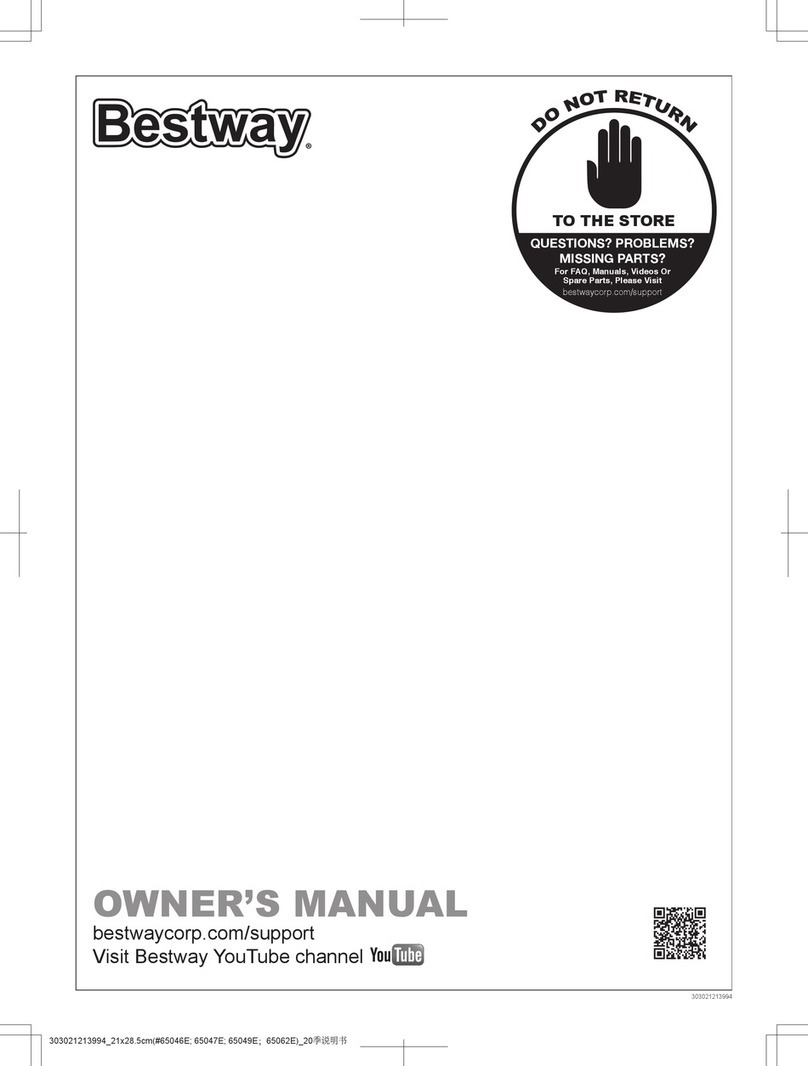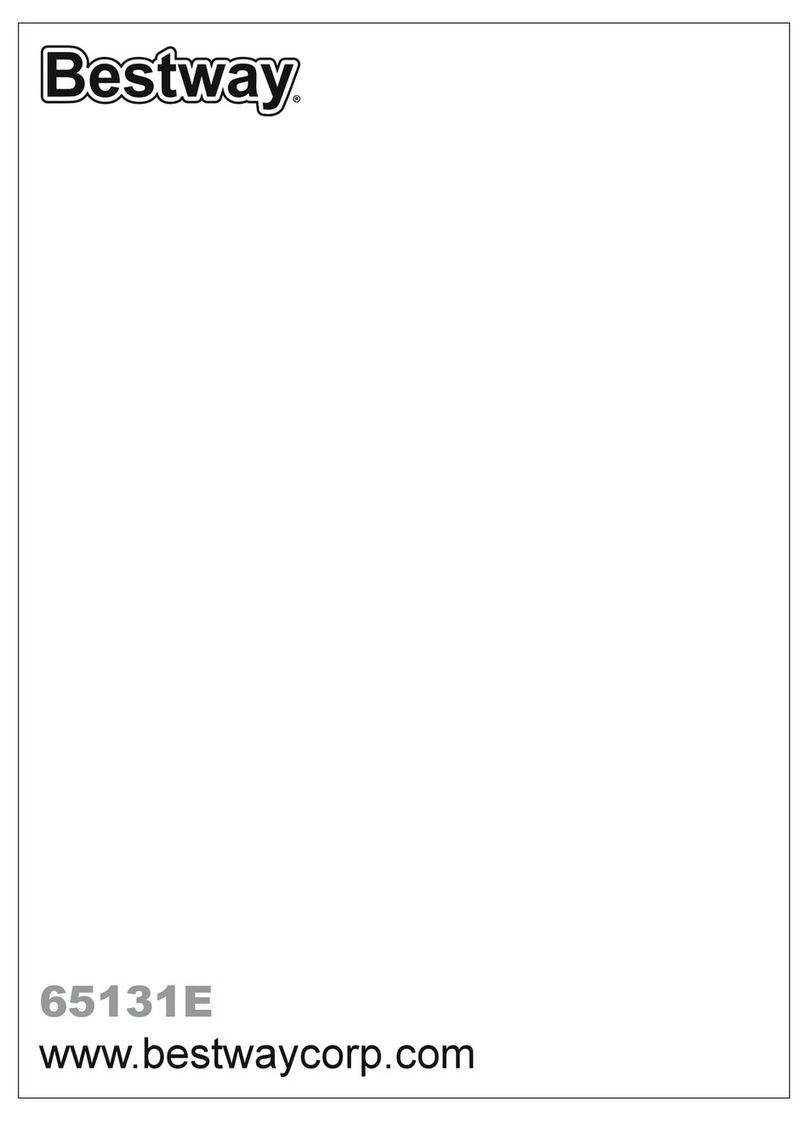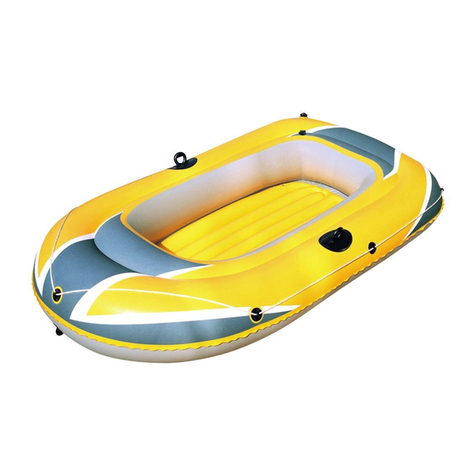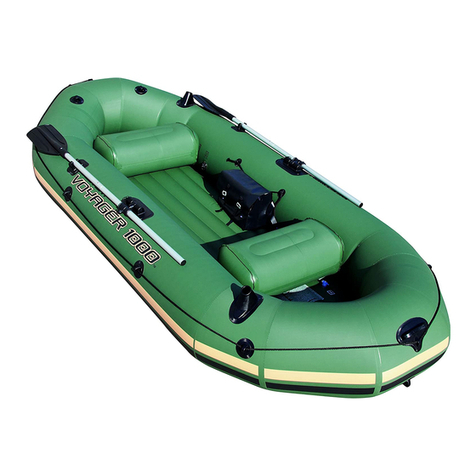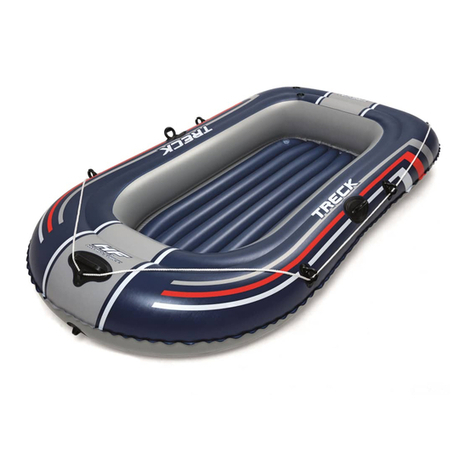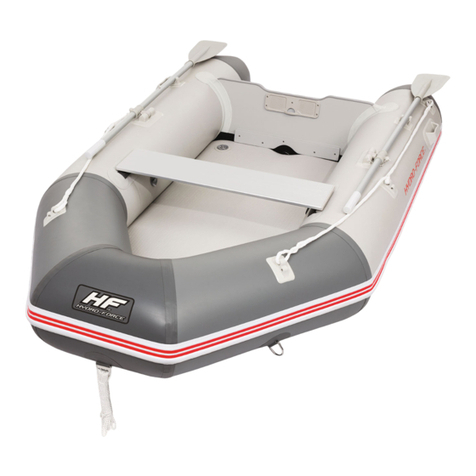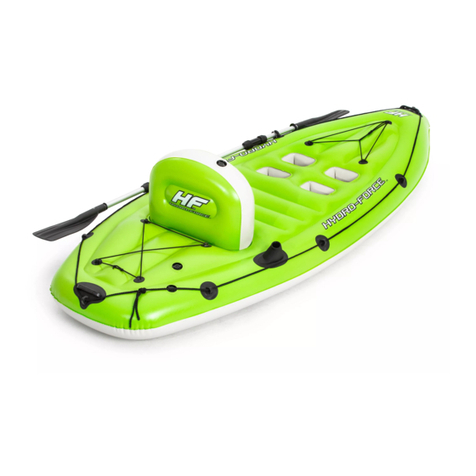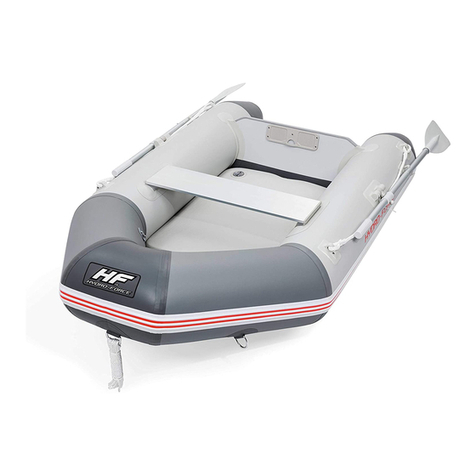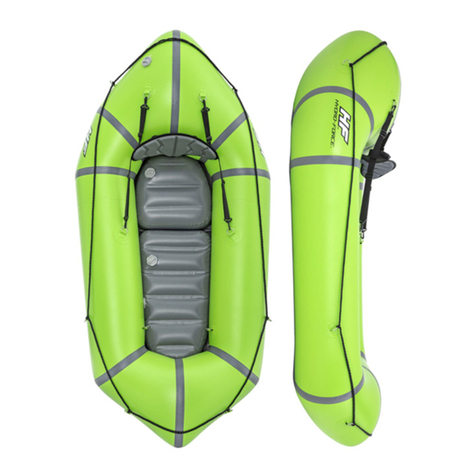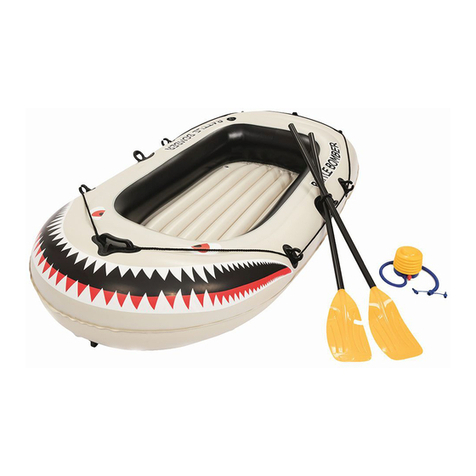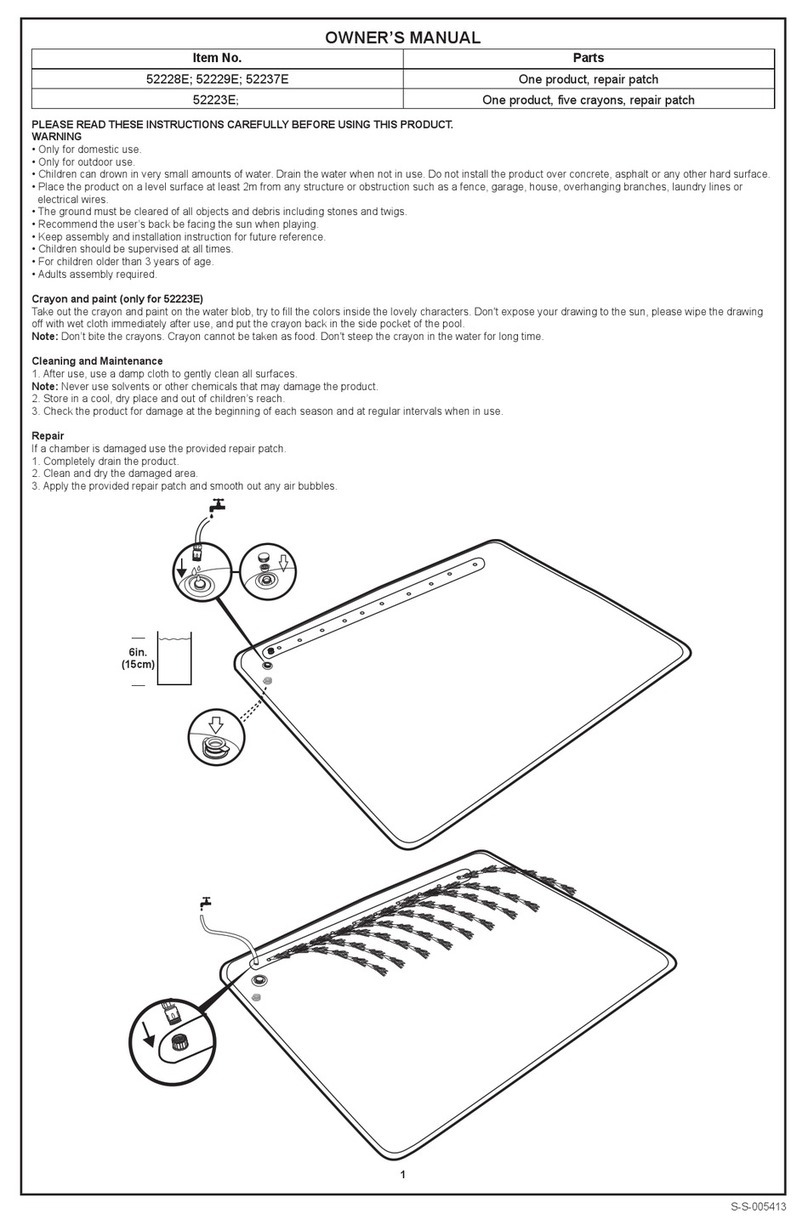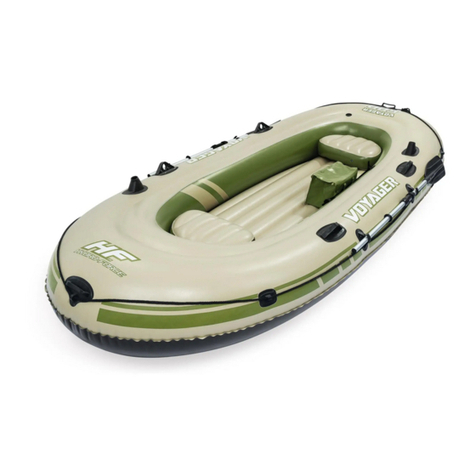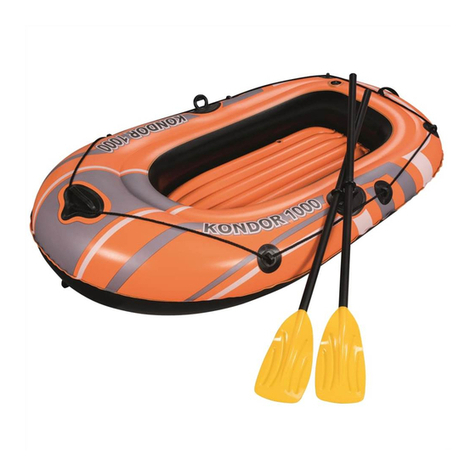
OWNER’S MANUAL
IMPORTANT SAFETY INSTRUCTIONS
Follow all the Safety and Operating Instructions. If you don’t follow these instructions, it may cause the boat to overturn or explode and result in drowning.
WARNING
• The boats are designed and manufacture in conformity with ABYC H-28 or ABYC H-29(only for Kayak).
• Do not mix old and new batteries and Do not mix alkaline, standard (carbon-zinc) or rechargeable (ni-cad, ni-mh, etc.) batteries.
• To avoid damage to the boat and injury to passengers, please don’t exceed the data given on the builder’s plate.
• When using the boat, life saving devices such as life jackets and buoys should be pre-inspected and used at all times.
• Before every use, carefully inspect all boat components including air-chambers, grab ropes, oars, and air valves, to ensure everything is in good condition and tightly secured. If you find any
damage, please stop to repair it.
• Buckets, water scoops and air pumps should always be available in case of air leakage or if the boat takes on water.
• When the boat is in motion, all passengers must remain seated at all times to avoid falling overboard. Keep the boat balanced. Uneven distribution of persons or load in the boat may cause the
boat to overturn and result in drowning.
• If one chamber is punctured when the boat is in the water, it may be necessary to fully inflate the other air chamber to prevent the boat from sinking.
• Be careful when landing on the shore. Sharp and rough objects such as rocks, cement, shells, glass, etc. may puncture the boat. To avoid damage, do not drag the boat on rough surfaces.
• If you accidentally fall overboard, grab the safety rope around the boat and climb aboard.
• Be aware of the potential harmful effects of liquids such as battery acid, oil or petrol. The liquids may damage your boat.
• Inflate according to the numbered air chamber and rated pressure of the boat, or it will cause over-inflation and potential and boat explosion. Exceeding the data given on the capacity plate may
cause the craft to be damaged, overturn and lead to drowning.
• Know how to operate a boat. Check in your local area for information and/or training as needed. Inform yourself about local regulations and dangers related to boating and/or other water activities.
• The operator of a vessel is responsible for the maintenance and safe conduct of the vessel and the safety of passengers.
• Product misuse is prohibited, such as, but not limited to: (a) riding backwards, gunwale, or in any other unsafe position, (b) failure to use handhold, (c) overloading or improper loading, (d)
excessive speed for the operating conditions, (e) using a boat in weather or sea conditions beyond the skill or experience of the operator, (f) continued operation with operator’s visibility blocked or
impaired (g) operating under the influence of drugs or alcohol, and/or (h) modifications.
• Boat operation where the boat operator or occupants are not under the influence of drugs and/or alcohol.
• Knowledge of federal, state, and/or local regulations concerning operation requirement, including: (a) discharge of oil, (b) solid waste disposal (Marpol Treaty), (c) marine sanitation, (d) speed, (e)
noise, and (f) wake.
• Knowledge of accident reporting requirements.
• The owner or operator of a vessel is required by law to render assistance to any individual or vessel in distress, as long as his vessel is not endangered in the process.
• When choosing an outboard motor, refer to the technical specifications section of this manual to determine acceptable horsepower ratings.
• For electrical motors equipped with batteries, note that battery acid can be caustic, which can cause damage to both skin and boat materials.
• For motors which use fuels such as gas, oil or petrol, since fuel is a flammable substance, it should be kept away from open flames. Further, clean the boat material immediately if fuel spatters onto
the boat surface. Be aware of the potential harmful effects of liquids such as battery acid, oil or petrol. The liquids may damage your boat.
• If you need to register your boat, please have the boat Hull Identification Number and model name ready and then visit bestwayusa.com/support to obtain your Certificate of Origin, or you can send
• The HIN is located on the starboard outboard side of the hull and near the stern.
NOTE:This equipment has been tested and found to comply with the limits for a Class B digital device, pursuant to part 15 of the FCC Rules. These limits are designed to provide reasonable
protection against harmful interference in a residential installation. This equipment generates, uses and can radiate radio frequency energy and, if not installed and used in accordance with the
instructions, may cause harmful interference to radio communications. However, there is no guarantee that interference will not occur in a particular installation. If this equipment does cause
harmful interference to radio or television reception, which can be determined by turning the equipment off and on, the user is encouraged to try to correct the interference by one or more of the
following measures:
- Reorient or relocate the receiving antenna.
- Increase the separation between the equipment and receiver.
- Connect the equipment into an outlet on a circuit different from that to which the receiver is connected.
- Consult the dealer or an experienced radio/TV technician for help.
CAUTION: Changes or modifications not expressly approved by the party responsible for compliance could void the user’s authority to operate the equipment.
TECHNICAL SAFETY INSTRUCTIONS
• Do not exceed the maximum recommended number of people. Regardless of the number of people on board, the total weight of people and equipment must never exceed the maximum recommended load. Always use the seats/seating
spaces provided.
• When loading the craft, never exceed the maximum recommended load: Always load the craft carefully and distribute loads appropriately to maintain design trim (approximately level). Avoid placing heavy weights high up.
• The maximum recommended load includes the weight of all people on board, all provisions and personal effects, any equipment not included in the light craft mass, cargo (if any) and all consumable liquids (water, fuel, etc.).
• Use the craft in sheltered water, up to 300 m (984 feet). Be careful with natural factors such as wind, tide waters and tidal waves. Be aware of offshore winds and currents.
• If you use the tow rings to tow the boat, go slowly to avoid over-towing as damage may occur.
• The boat is intended for beach use, short-time and short-distance cruising.
• U.S.Coast Guard Info line: (800)368-5647. Web site: www.uscgboating.org
• Drawings for illustration purpose only. May not reflect actual product. Not to scale.
SAVE THESE INSTRUCTIONS
SAFETY ROPE INSTALLATION
• Safety ropes shall be fitted to both sides of the bow and stern areas only and shall not impede the normal operation of the craft.
• Do check carefully if the saving rope is tightened well.
SEAT AND FOOTREST ASSEMBLY
• After the craft is inflated, connect the belts of the seats and footrest to the side buckles on the craft.
• The location of the seats and footrest can be adjusted along with the craft floor.
MAINTENANCE AND STORAGE
• Remove all accessories.
• Carefully clean the boat using a mild soap with clean water. Do not use acetone, acid, and/or alkaline solutions.
• The product can be dry under direct sunlight for not more than 1 hour, extended exposure to sun can shorten the lifespan of the boat.
• Use a dry cloth to gently clean all surface.
• Store in a cool, dry place and out of children's reach.
• If the product will not be used for a long time, please remove the battery inside the pump.
REPAIR
• If there is a small puncture, repair it according to the instructions on the repair patch.
• If the hole is too big to be repaired with the provided patch, purchase a Bestway repair kit or send the boat to a specialty shop to make the repair.
PLEASE KEEP THIS MANUAL IN A SECURE PLACE, AND HAND IT OVER TO THE NEW OWNER WHEN YOU SELL THE CRAFT.
TECHNICAL SPECIFICATIONS
INFLATE & ASSEMBLE
NEVER USE HIGH PRESSURE AIR TO INFLATE INFLATABLES. THIS CAN DAMAGE YOUR PRODUCT.
• Inflate only as far that after inflating one can see some folding at the welding seams. After inflation compare the height of the printed scale on the product with the following table to make sure
reach the height of each chamber is reached. DO NOT OVER INFLATE.
• Take care that the boat has gotten to the correct pressure. Pay attention to both pressure scales on the type-plate and check the pressure from time to time, because in the sun the pressure can
grow and it must be balanced then to the correct one.
• Extended exposure to sun can shorten the lifespan of your boat. We suggest to not leave boats in direct sunlight for more than 1 hour after use.
Item
65174E
65173E
Inflated Size
12 ft. 8 in. x 38 in. x 14 in.
(3.86 m x 96 cm x 35 cm)
Recommended bilateral
chamber working pressure
0.14 bar (2 psi)
Recommended bottom
working pressure
0.07 bar (1 psi)
Maximum
load capacity
397 Ibs (180 kg)
Dry Weight
37.61 Ibs (17.06 kg)
Maximum number
of persons
2 adults
4
303021321676
